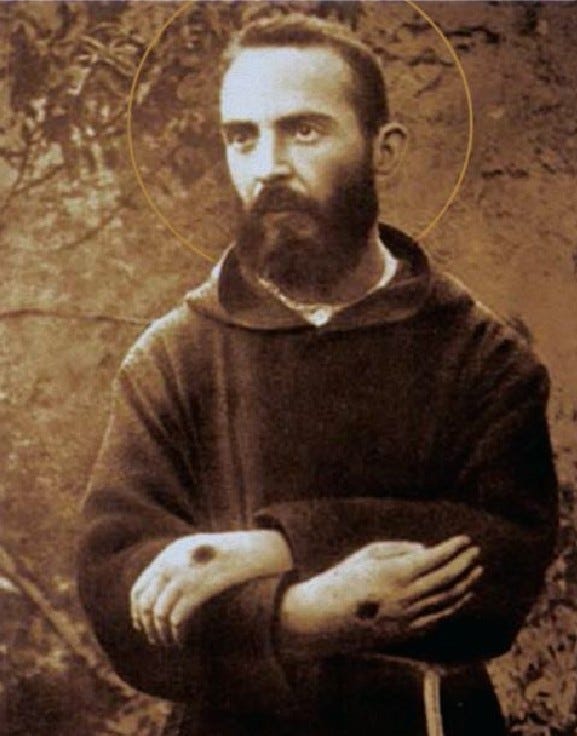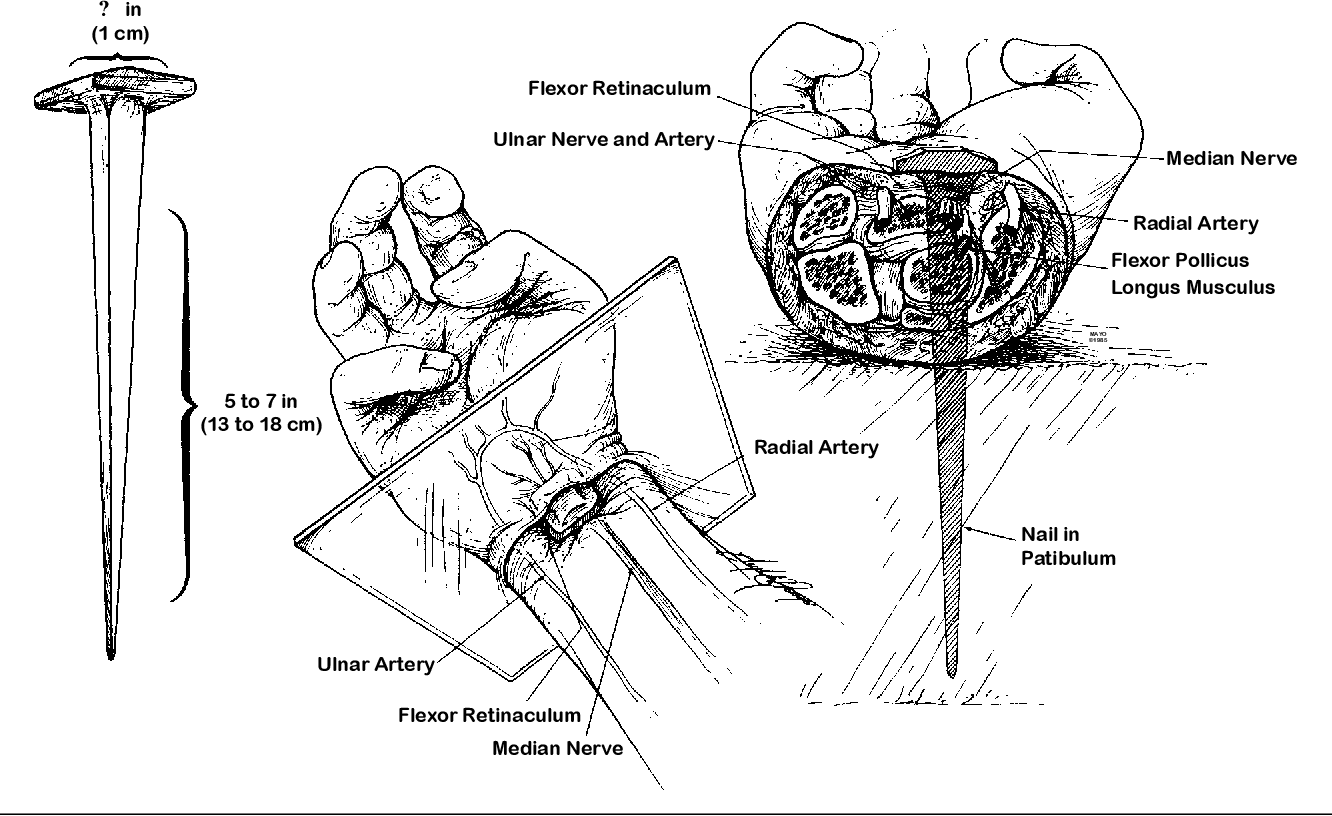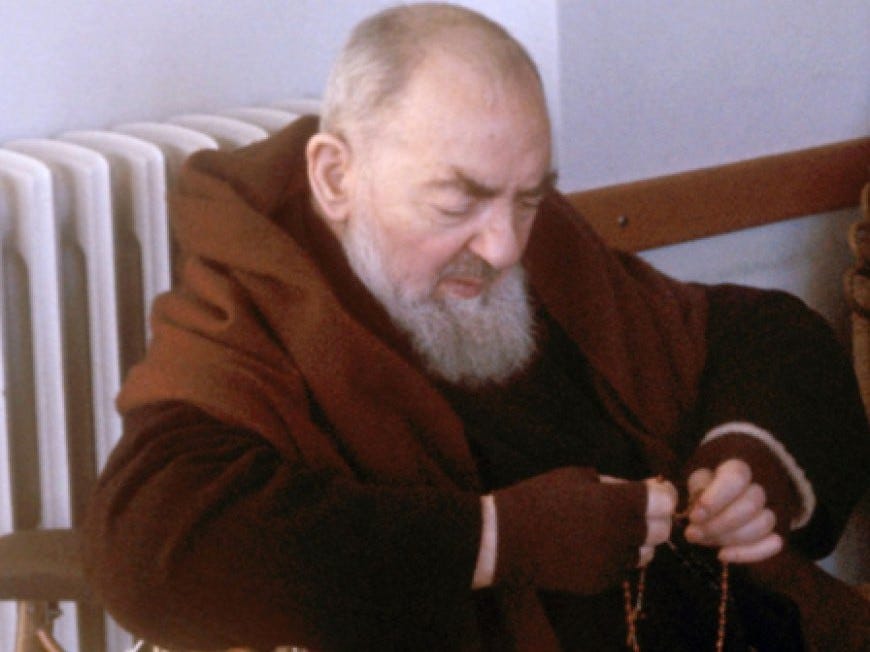Disclaimer: This post is not intended to promote or discredit Christianity or any other faith groups; the sincerity or overall character of Padre Pio; or “miracle” claims as a whole.
Each point listed above (as well as others that will be addressed in subsequent posts) are topics that deserve their own investigations. We will examine the evidence of each topic on its own merits.
Let us first look at some of the claims and accolades associated with Padre Pio:
Pio (born Francesco Forgione) was an Italian friar turned iconic priest. He is considered a miracle worker who bore the marks of Christ. Despite the clash he had with high ranking church officials—including a pope—he was made a saint.
We will not be looking at his sermons, teachings, or all of the miraculous claims associated with Padre Pio. Instead, we will examine the stigmata that became associated with him.
What are stigmata? The Merriam-Webster dictionary defines stigmata (the plural of stigma) as “bodily marks or pains resembling the wounds of the crucified Jesus and sometimes accompanying religious ecstasy.”
In 1971, three years after Padre Pio's death, Pope Paul VI speaking of Pio stated, "it is not easy to say it.... (Pio) bore the wounds of our Lord. He was a man of prayer and suffering." *
In 1910, the year Pio was ordained as a priest, he had his first personal encounter with stigmata. Unlike the ones he would later be known for, these stigmata were not exactly visible, save for a possible slight reddening. These are known as “invisible stigmata” and are merely felt by the possessor. They are not detectable by any sort of medical or lab equipment. He later wrote about this event:
“Then last night something happened which I can neither explain nor understand. In the middle of the palms of my hands, a red mark appeared, about the size of a penny, accompanied by acute pain in the middle of the red marks. The pain was more pronounced in the middle of the left hand, so much so that I can still feel it. Also under my feet, I can feel some pain.”
Only a year prior to this, a book by Father Germano Ruoppolo was published: Letters and Ecstasies of the Servant of God, Gemma Galgani. It was the second book written by Father Ruoppolo regarding Miss Galgani, a mystic who was later beatified (the step before sainthood in the Catholic faith). Prior to Pio, Galgani bore the stigmatic scars of Christ.
Miss Galgani was a contemporary of Pio. She was about nine years older and lived in Northern Italy, whereas Pio lived in the South.
As a member of the clergy, raised in a devout Roman Catholic family and culture, Padre Pio would have known of Miss Galgani, her stories and her stigmata.
In fact, in a letter from Padre Pio to Padre Benedict written on May 2, 1912, it is clear that he knows of her and the books about her, writing, “... Moreover I am asking you for charity: I would like to read the booklet 'Letters and Ecstasies of the Servant of God, Gemma Galgani,' as well as the other one of the same servant of God, ‘The Holy hour.' I am sure that you will agree and meet my desire. Bless me. Padre Pio."
In his book Padre Pio: Miracles and Politics in a Secular Age, the historian Sergio Luzzatto cites a letter from Pio to one of his spiritual directors, Father Agostino:
“We do not know whether Father Agostino, reading these words, realized that Padre Pio had copied them verbatim from a letter by Gemma Galgani. Nor do we know whether he or Father Benedetto were aware that a dozen other letters by Padre Pio, written between September 1911 and May 1913, reproduced word for word—without citing it—items from her ‘Letters and Ecstasies'... but, to confuse matters further, he sought to make them believe that he did not even possess Gemma's book.”
Luzzatto later writes that, "For months, Padre Pio had been copying out sentences from [Letters and Ecstasies and The Holy Hour] and he would continue to do so for another entire year.”
Despite Pio being supposedly unaware of Gemma Galgani, he was well aware of what stigmata were and the attention that came from them. According to an essay based on Giuseppe Caccioppoli's 2013 interview for PadrePio TV, Padre Pio was also familiar with Saint Francis of Assisi (circa 1181-1223), one of the most well known saints to have stigmata. The essay states: On January 6, 1903, Francesco [Pio] left home for Mercone, to begin the novitiate in the Capuchin's Order. His mom gave him a Rosary (still preserved) and said: "My son, Saint Francis has called you, and you must go."
Other stigmatics include St. Catherine of Siena, St. Faustina Kowalska, St. Rita of Cascia, and Domenico da Cese (who was given the title of "Servant of God" in 2015). Da Cese was a friend of Padre Pio's and a fellow monk in the Capuchin order (founded by Francis of Assisi).
For this reason alone, it would not seem a foreign notion that someone could possess stigmata, although it might be an odd and rare occasion to witness or experience firsthand.
Skipping ahead to 1918, while listening to confessions, Pio claims to have another experience with stigmata on his body, only this time the wounds were entirely visible and bleeding. News of the stigmata and his other miracles began to spread and in two years the Vatican started imposing sanctions with regards to Pio conducting masses and addressing the public, as well as restricting him from showing his stigmata publicly.
Over the next several years Padre Pio’s stigmata were examined by physicians, doctors, and even clergymen. Several of these examinations were favorable to Pio’s cause, such as Bishop Rossi’s, which concluded that the stigmata were not “the work of the devil” nor were they the result of “deceit, fraud or a malicious or evil ability. Much less were they the result of external suggestion, nor do I consider them to be the result of suggestion.”
Notwithstanding the support of many in the church, The Holy See (the government of the Roman Catholic Church) made statements over the next few years denying that the miracles and stigmata were due to divine cause. Nor were the stigmata submitted to the special Vatican tribunal as evidence for consideration for the canonization of Padre Pio. These last points alone are not grounds for dismissing Pio's stigmata as genuine. The Holy See may have merely been cautious on what they accept and share with the public. Also, the required prerequisite for Pio's canonization may well have been met without considering the stigmata.
Padre Pio’s claims of stigmata are not unique nor did they set a precedent within Roman Catholicism, which had previously canonized stigmatic saints. So it is noteworthy that not all examiners and clergymen were confident in Padre Pio's claims. In fact, two popes in succession doubted the divine claim and authenticity of his stigmata.
One examination, led by Father Agostino Gemelli, on behalf of the Holy Office, did the most "damage" to the credibility of the stigmata in that he pointed out the stigmata's likeness to wounds brought on by purposeful application of a caustic substance. Father Gemelli was a Franciscan friar and a physician, who founded the Università Cattolica del Sacro Cuore (Catholic University of the Sacred Heart) of Milan.
Gemelli, in response to a critique of his examination report, stated, "Anyone with experience in forensic medicine, and above all in the infinite variety of sores and wounds that self-destructive soldiers presented during the war, can have no doubt that these were wounds of erosion caused by the use of a caustic substance. The base of the sore and its shape are in every way similar to the sores observed in soldiers who procured them with chemical means. The color of the base, the shape of the margins, their thickness, etc., all suggest this."
In support of this theory, in 1919, a young, religious woman named Maria de Vito went to see Padre Pio. She was the cousin of a pharmacist in the Province of Foggia, the same Province where Padre Pio lived and ministered. Maria deVito received a request from Pio in a note. Her cousin, the pharmacist, recounted the event to Monsignore Salvatore Bella, the local Bishop, stating, "When she returned to Foggia she brought the greetings of Padre Pio and asked me in his name, and in strict secrecy, for carbolic acid, telling me that Padre Pio had need of it, and giving me the little bottle he had given her, capacity 100g, and with a skull and crossbones."
Though it was not stated whether this container was previously used for storing carbolic acid or not, it is clear that Padre Pio has used carbolic acid before. In Frank M. Rega's book Padre Pio and America, he notes that "Due to a shortage of doctors, Padres Paolino and Pio administered the shots, using carbolic acid as a sterilizing agent."
Carbolic acid, or phenol, is a highly acidic substance that is typically used as a cleaner or disinfectant. Due to its high acidity, it eats away at flesh and other soft biological tissue.
As for the placement of the nail marks on the hands of Jesus Christ, these have traditionally been assumed to be roughly in the center of the palms. This is not surprising, as even the artwork of the crucified or risen Jesus over the centuries depicts the nail wounds being in the center palm area. Note the term "hand" or "χειρ" in the original Greek in the Gospel of John, chapter 20, where the Apostle Thomas speaks of the nail marks in Jesus' χειρ. The Nida & Louw, Greek-English Lexicon of the New Testament Based on Semantic Domains (Vol. 1, p. 98) states the word ‘χειρ' can apply to the hand or any relevant portion of the hands, including, for example, the fingers.
Historical and medical research has recently shown that the center of the palm was not the proper placement of a nail as the muscles and bones in the hand are not strong enough to support the hanging body. The three methods used for nailing the victim’s hands to a cross were: through the bottom part of the palm and out through the wrist; nailed directly through the wrist; or between the ulna (the two bones of the forearm). The third method is not only the most secure way to anchor an individual to a cross, it is also one of the most painful. A nail through the wrist pierces through the median nerve which causes the hand to curl up in a claw-like fashion and sends a pain resembling electricity continually running down the arms. Any movement of the individual causes the nail to rub against the median nerve.
The last thing to consider regarding Padre Pio's stigmata is their disappearance after his death. As experience would suggest, wounds don't typically fade overnight, especially ones as severe and long lasting as Pio’s, and never after the body has died. This would be a strong case for the miraculous nature of the stigmata as the healing of bodily wounds after death is practically unprecedented, save for claims in the Bible and other religious writings.
Over the years Padre Pio was seen wearing fingerless gloves, supposedly worn for the sake of covering his stigmata. However, there may be an ulterior motive behind the gloves—to hide the fact that the wounds may not have been present at all times, especially toward the end of his life. Carbolic acid burns are not only toxic to the body with continual exposure but are also extremely painful. The gloves would eliminate the need for a painful process to keep up the stigmatic appearance.
Raffaele Rossi, the Bishop of Volterra, who stood in favor of the authenticity of the stigmata of Padre Pio, described them in his final examination report, stating those in the hands were "very visible,” whereas the ones in the feet "were disappearing. What could be observed resembled two dot-shaped elevations with whiter and gentler skin."
This suggests that the ones on the feet—which were likely the least seen stigmata, along with the one on the chest—healed and faded over time. The last official examination of Padre Pio's stigmata was in 1925, forty-three years before his death.
In 2021, Father John Aurilia, OFM Cap. (Padre Pio's personal secretary) took part in a phone interview on the Reason and Theology podcast and addressed the disappearance of Pio's stigmata:
"The stigmata disappeared about a month, a month and a half before he died. Completely healed. Nothing there… So we called the bishop. Said, 'What do we do now because people know that Padre Pio has the stigmata? But there is no stigmata. So it's a problem here.' And the bishop said, 'There is no problem at all. Dress Padre Pio the way he was dressed in his lifetime.”…Socks, sandals, gloves—you know half gloves—and you know the chest covered.”
If Padre Pio allowed the wounds to heal, it would be an easy matter to a) recreate the carbolic acid scars for a season or b) cosmetically replicate it.
This examination does not aim to discredit Padre Pio or his ministry nor attempt to disprove supernatural acts as a whole. We did our best to argue against the claims that Padre Pio's stigmata were of divine origin. We've examined them from various perspectives, including:
Historic research about the nail wounds of Jesus and other crucifixion victims and how they differ from the placement of Padre Pio’s.
Pio's knowledge of stigmatics in Catholic history/tradition.
His dishonesty in pretending to be unaware of another Italian stigmatic and passing off verbatim quotes from her books as his own words.
His ability to obtain and apply a substance able to create convincing stigmata.
Clergymen in his circle and two popes doubted the authenticity of the stigmata.
I hope the information shared here has encouraged you to examine everything from all sides, including claims that you may come across in the news, on the web, or by word of mouth.
*Cardinal O'Malley OFM Cap. Prayer, etc. Archdiocese of Boston.





